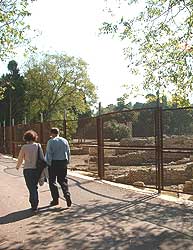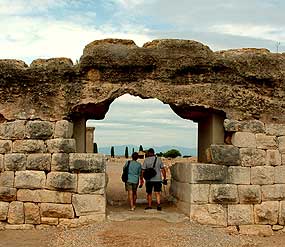The Ruins of Empuries
One does not have to be particularly interested in history or even interested in archaeology to succumb to the charm of the excavations of Empúries.

The Greeks settled here beginning during the sixth Century before Christ, and later the Romans selected the place for their settlement, surely not only from strategic considerations, but certainly because it also pleased them.
For numerous holidaymakers a visit of the ruins of Empúries is an annual vacation ritual. The excavations are less than two kilometres from L’Escala and can be reached by foot comfortably along the beach promenade. If you arrive from a direction other than the promenade you must look for the sign “ruines d’Empuries.” Care must be taken, for many visit attempts, even by university graduates find themselves at the ruins in Sant Pere Pescador and leave frustrated, hoping to find Empúries next time.

If you get by car, and find the correct indications, you can drive your the car quite close to the ruins and park there. Before entering you must purchase tickets, cash only, for 6€. This is a good bargain, and includes admission to the archaeological museum. In addition, you will receive an explanatory brochure with a helpful map. The brochures are available in several languages, including English. Plan to spend at least 1 hour 15 minutes for the main walkabout. If you have time, consider a longer visit. However, try to avoid midday. The walk to and through the excavations is unshaded and in general L’Escala it usually two degrees warmer than, for instance Roses. On the other hand an ideal day to visit is when the Tramonatana rages uncomfortably around the Cap de Creus. The Tramontana hardly ever affects this area, and if it does it will only be as a refreshing breeze.
The ruins and museum are open during the main season, i.e., from 1 June to 30 September from 10 to 20 o’clock, otherwise from 10 to 17 o’clock. At the ticket window or in the “Botiga” in the museum you can buy an official guidebook for less than 10 euro. We reviewed the English edition. The book is reasonably developed and generally understandable.
There is no parking inside the ruins and one must park in the nearby private parkings or leave the car in L’Escala and access the ruins through a pleasant walk along the awesome Empuries promenade.
The historical name of Empúries comes from the Greek term “Emporion” which means market place or commercial centre and correctly describes the purpose of the site. The city was favourably situated at the delta (at that time) of the (river) Fluvia and at the crossing of several trade routes. The natural harbour basins in front of Emporion offered protection to the trading vessels.

The actual town foundation for the 6-century before Christ buildings are not part of the visible excavations. The oldest building ruins are under, or were replaced by, the village St Martí d’Empuries. This village with its restored centre and the late gothic church is also a popular destination. The sand beach directly in front is beautiful and in the best way maintained…
… and is in point times also accordingly frequented. If you do visit St. Martí d’Empuries in the off-season (and we really recommend a visit), should not forget, if it is good weather, trunk and towel.
Some history
In the V century before Christ the Greeks shifted Emporion to the location of the current excavations (the current St Marti d’Empuries). Emporion became rapid one of antiquity’s most important commercial ports of the Mediterranean.
During the second Punic war, in the third century before Christ, Emporion became a Roman possession, called Emporiae. This was the beginning of the romanisation of the Iberian Peninsula.

Julius Caesar probably found Emporiae to be a special place. He built a new Roman settlement behind the originally Greek city that was ten times larger than the prior one (today we would call the addition an urbanisation) for homes for war veterans. So that the inhabitants were not bored, he – naturally – constructed an Amphitheatre and for the sport training of the citizens he had a sports field built. Fashion shops and taverns were grouped around the forum. The homes were not the dull drab architecture of a social welfare-building project; mansion fragments show the construction to include generous sized facilities and wonderful ornamentation mosaics on the floor.
Later, Empúries lost its importance, in the third Century after Christ the city was completely abandoned. When, during the 17-century, fishermen created L’Escala, many Greek and Roman stones from Emporion or Emporiae served as the building material.


Today…
Examples of Greek and Roman town construction art and their essential structures can be visited in Empúries: The Greeks adapted their places to the site and the terrain, while the Romans designed their plan and made the land accommodate their chessboard-similar raster pattern for their cities.
The visible excavations in Empúries began in the year 1908 and continue today. Only about 25 % of the surface is observable.
It is not our intention to offer more than a superficial description of the excavations of Empúries. We would like to urge, however, that our readers visit Empúries. You will be moved by the experience. Go for any or all of the following reasons: to spend some moments at a quite special place, or to impress the children with the remnants of a bygone era, or to learn more of man’s history. Your visit in springtime will present a peaceful time to imagine how our ancestors lived.
GPS: 42.13057 N, 3.12037 E
GOOGLE STREET VIEW:
————————————————————————————–
Imatges de les Ruïnes d’Empúries
————————————————————————————–




















Hello,
Is it possible to visit Ampurias with a group 30 pax on Monday Oct 11 in the afternoon?
Best regards,
Björn Efraimsson
PARADISRESOR
SWEDEN